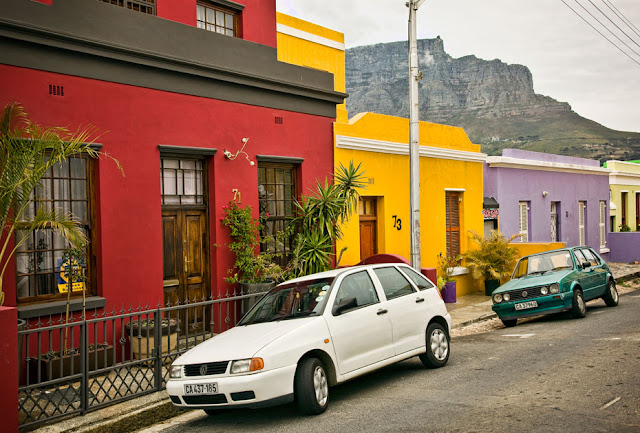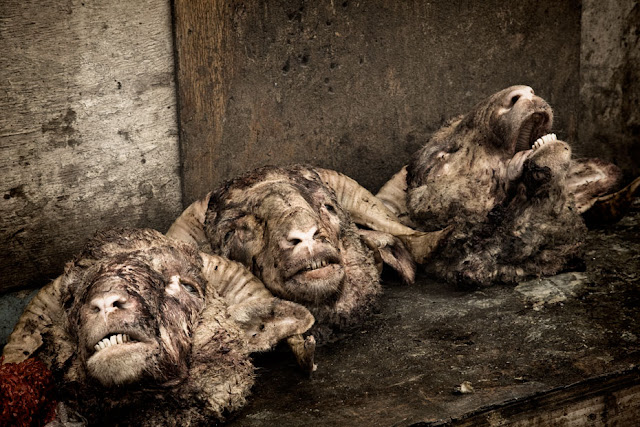Woke to an exceedingly grey morning, with intermediate rain, needless to say Table Mountain was off the cards yet again, I couldn’t even be bothered to lament at the situation, instead I went down to breakfast and stuffed myself with an inhuman quantity of pancakes.
Feeling overstuffed and under whelmed we drove into the city and took a gander at the Bo Kaap, or the Cape Malay Quarter. This section of Cape Town was originally established after the years of slavery in the city throughout the 18th century, when people were shipped in from around the world, especially from Indonesia, which was a Dutch colony for several centuries. They were the first to bring Islam to South Africa.
 |
| The sky may be grey but the houses are sunny |
Although it is called the Malay community it should be more accurately called the Muslim community as most of the inhabitants speak Afrikaans or English, but no longer the Malay languages. But whatever they speak, they sure know how to paint up a storm. The area includes a number of streets, full of houses covered in various vibrant hues and make for an arresting site and decent way to spend a couple of hours, camera in hand.
 |
| Shame the cars aren't painted in a similar fashion |
After that we headed to the main shopping area of the city and wandered around stalls that sell everything you could ever wish to own craft wise from the African continent. After a quick coffee stop, we passed what looked to be a very interesting building, so thought we would take a peek inside. What we had inadvertently stumbled upon was of course the PanAfrican Market.
This craft market is located in an old Victorian house which has basically kept its original layout intact, which means three floors of narrow corridors leading to what seemed like endless high ceilinged rooms, all absolutely jam packed with a positive jamboree of African paraphernalia, literally right to the rafters. There is something about entering a room and seeing a 10ft high wall of African masks peering at you to make you think, that surely is a lot of African masks and no mistake.
Extremely interesting to wander around in, there is so much stuff to see and buy. I had my eye on a Samburu hunting spear, but at 6ft long and topped with an dauntingly injurious spearhead, I though it might prove a slight problem when getting it on the plane as hand luggage. Although I’m pretty sure gently resting it on the shoulder of the person sat in front of me might dissuade them from reclining their seat into my lap, as they are wont to do.
Earlier on we’d booked a tour of the Townships so we arrived back at the hotel for our allotted pick up time. After alighting the minibus our first stop was the District 6 Museum so we could get a background on the history of the Townships. It was really interesting but we didn't have enough time there to see all it had to offer, if we’d had a longer period left in Cape Town it would have definitely been worth going back there, it was well laid out and the stories told were fascinating and moving.
Thankfully our guide for the afternoon was a bubbling fountain of knowledge and easily filled us in on what we had missed. He was a chief in the LangaTownship, the first one we were to visit, and obviously cared deeply about the welfare of its inhabitants. Of all the things I learnt on the tour, probably the most surprising for me was what actually a township is.
Whenever I’ve seen items on the news that have involved them, the images have all been of shanty towns areas, corrugated sheds and suchlike, in fact the townships proper are predominantly estates of brick buildings, built by the apartheid government for their black and coloured citizens who they had displaced from areas that were declared white only.
Whenever I’ve seen items on the news that have involved them, the images have all been of shanty towns areas, corrugated sheds and suchlike, in fact the townships proper are predominantly estates of brick buildings, built by the apartheid government for their black and coloured citizens who they had displaced from areas that were declared white only.
 |
| Looking out from one of hostels into the communal yard |
The shanty town areas, and there are plenty of them, sprung up because there was not enough housing for everyone, despite the fact that entire families can live in a single room. As more people head to the cities from the countryside, or from neighbouring countries, they continue to grow apace, but these areas are referred to as informal settlements, quite distinct, in linguistic terms at least, from Townships.
When we arrived at Langa, a Township that consists of around 500,000 people, and departed from our minivan, another local guide took us for a wander through the streets, where we got to see the hostels that were originally built for the male workers only; it was at first illegal for their wives and families to join them.
They were overcrowded to begin with but when families were at last allowed, the conditions became a lot worse, everyone would share one cooking area and bathroom between them. They are unfortunately still used by families waiting for more suitable housing to become available.
They were overcrowded to begin with but when families were at last allowed, the conditions became a lot worse, everyone would share one cooking area and bathroom between them. They are unfortunately still used by families waiting for more suitable housing to become available.
 |
| A local business that sells the best parts of sheep's heads |
 |
| These being the heads that the best parts come from |
Next we took a walk into the informal settlement part of Langa, and were just in time to see the tail end, so to speak, of the slaughtering of a goat. They were in the process of butchering it and I have to say it didn’t smell too good. Not sure who I felt more sorry for, the goat, or the small child who’s job it was to clean out the gut, and who was literally, in deep shit.
We partook of the local beverage, a type of beer called Sorghum, just don’t ask me to say it, as it includes a type of clicking sound, and I can’t even roll my R’s. It was of a milky and frothy consistency and didn’t taste that bad, slightly bitter and I probably wouldn’t order a pint of it, but for a few sips it was OK.
Sarah managed to get befriended by a small boy who’s mother we had just visited, and he seemed to take a shine to her, I was just commenting on how his choice left a lot to be desired when he grabbed my hand as well and proceeded to make it very clear we should be lifting him up and flinging him about as we walked on. I don’t think he could have chosen a couple of less suitable surrogate parents but he seemed oblivious to such things and was having a whale of a time, which I assume he gets to repeat with the arrival of every new group.
 |
| Langa Informal Settlement |
 |
| Langa Informal Settlement with mountains behind |
After a quick ride back on the minibus we arrived at the largest Township in Cape Town; Khayelitsha, it is reckoned it has a population of around 1 million and is growing at a rapid rate.. We visited Vicky’s B&B which seemed rather comfortable. And it’s had its fair share of publicity judging by the newspaper clippings on the wall.
As we left Khayelitsha I tried to imagine what it must be like living in such a place, not the B&B you understand, a Township, I think it would be the lack of space that would be the most difficult. Everyone seemed well dressed and well fed, as in not walking around in rags and starving, although I’m sure food isn't plentiful, as unemployment is incredibly high so money is not in abundance to say the least. But the day to day existence of living in such overcrowded and basic conditions seemed overtly oppressive.
 |
| Crossroads at Khayelitsha |
 |
| Informal Settlement Khayelitsha |
So I guess my overall feeling was one of depression, mainly I suppose because it’s so far outside of what I’m used to, coming from a comparatively, much better off environment, it made me think I should be thankful for what I’ve got. And with that inadequate and ultimately hollow cliché ringing in my head it was time to get back to the hotel and find somewhere that served a damn good steak.
And we did in fact find that place, it was an Italian/Portuguese restaurant called Beleza and was probably one of the finest steaks I have ever had, ever.
 |
| View of the city on our last night in Cape Town |
No comments:
Post a Comment